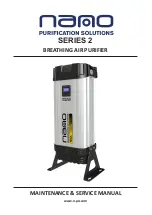
06_
safety information
safety information
CAUTION SIGNS
Do not place containers with liquid or other objects on the unit.
Do not pull the indoor unit.
• If the indoor unit falls, it may cause personal injury.
Do not allow children to climb on the air conditioner.
Do not touch the pipe connected to the air conditioner.
• Potential risk of personal injury or burn.
The air conditioner is composed of moving parts. Keep children away from
the unit to avoid physical injury.
Check for damage on delivery. If damaged, do not install the air conditioner
and call the place of purchase immediately.
Make sure the voltage and frequency of the electric system are compatible
with the air conditioner.
Insert the dust filter before operating the air conditioner.
• If there is no dust filter inside the air conditioner, accumulated dust may shorten the life of
the air conditioner and cause electricity waste.
Keep indoor temperatures stable and not extremely cold, especially where
there are children, elderly or disabled people.
Clean the conditioner after the inner fan stops operating.
•
Potential risk of injury or electric shock.
Clean the dust filter every 2 weeks. Clean the filter more frequently if the air
conditioner is operated in dusty areas.
Inspect the condition, electric connections, pipes and external case of the
air conditioner regularly by a qualified service technician.
Do not open doors and windows in the room being cooled during operation
unless necessary.
Do not block air conditioner vents. If objects block the air flow, it may cause
unit malfunction or poor performance.
The packaging material and used batteries of the remote control(optional)
must be disposed of in accordance with the national standards.
The refrigerant used in the air conditioner must be treated as chemical
waste. Dispose the refrigerant following national standards.
Have a qualified service technician install the air conditioner and perform a
trial operation.
Install the air conditioner away from direct exposure to sunlight, heating
apparatus, and humid places.
•
Hang a curtain to boost cooling efficiency and to avoid the risk of electric shock.
Firmly connect the drain hose to the air conditioner for a proper water
drainage.
•
If it is not drain well, the condensed-water from the indoor unit may overflow and leak into
the room.
Install the outdoor unit where operating noise and vibration will not disturb
your neighbor and be well-ventilated with no obstacle.
•
Potential risk of malfunction.
•
Operating noise may disturb your neighbor.






































